|
3rd July 2015, Burton Mere RSPB
A trip to a second RSPB site within a couple of weeks, this time hoping to see the Northern Marsh x Southern Marsh hybrids reported to be there; especially as these are said to be uncommon with not only their geographical separation, but also because they are not that closely related within the Dactylorhiza complex.
Straight off though, it was the Bee Orchids south of the reception that made the day. Over 130 counted and some were well established plants growing up to 46cm with 11 flowers. Perhaps a week too late to see them at their best, but still impressive. A couple of slightly atypicals were seen. One showed a vertical yellow line running the entire length of the lip, and looking like it was the two halves of two different flowers joined together. The other had near circular lateral sepals.
A thought came to me looking at the site on a map. This reserve lies directly east of Freeman's Copse, another Bee Orchid site. Could that have been seeded by westerly winds blowing from here?
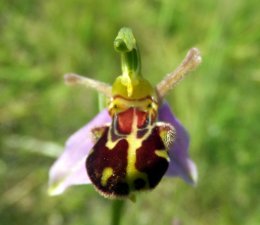 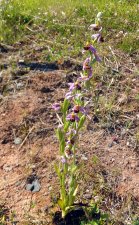 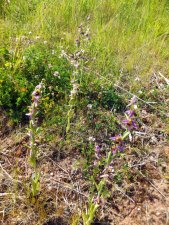 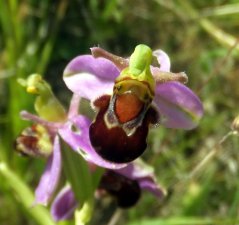
The Southern Marsh Orchids were largely finished, and to be honest not very numerous. Nothing that was overtly like a Northern Marsh Orchid was to be seen. There was a fair but of variation amongst the Southerns, but only the last example below made me consider the possibility of the hybrid we hoped to see.
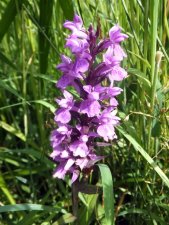 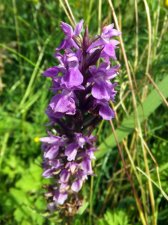 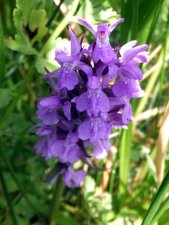 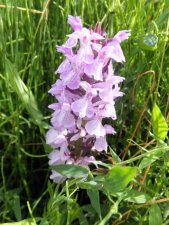 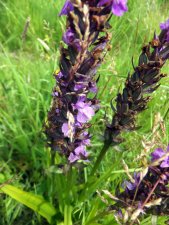
10th July 2015, Great Orme
The Dark Red Helleborines on Great Orme are worth a visit again and again. Today was a warm sunny day and a ride on the cable car was part of the schedule. This year we found 23 in flower, more than in previous years, and also 11 flowerless plants on the roadside. Previously the odd flower has seemed less red than normal, but this year a significant proportion of the flowers were lacking a degree of reddish colour, and one looked to be a deep khaki colour. Dark Red Helleborines are said to be variable in colors and no specific varieties are assigned to those seen here. Nice to see that at least a couple of flowers growing in the cliff above the road had persisted for at least another year.
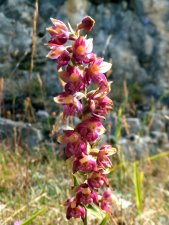 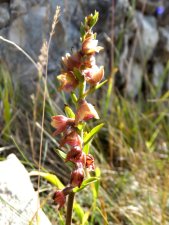 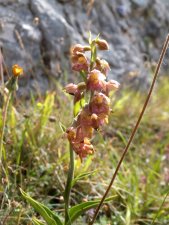 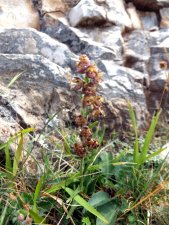
This year we decided to spend a bit more time on the Dark Reds. It had taken several visits before we actually saw any, as we were sidetracked into looking at the patches of Limestone pavement towards the northern tip of the Orme, before getting a tip-off as to where they grew on the roadside. But having reasoned that the roadside plants could have been seeded by a colony above, it seemed reasonable to look higher. The roadside plants grow beneath 200 foot of steep, terraced limestone the top levels of which are accessible from the summit. We made our way to a point directly above where we knew them to grow, and found more examples with ease. In total we found 25 flowering and 20 non-flowering plants along a 250 metre stretch of the highest terraces. Like down below, the plants seemed smaller to those seen in County Durham, and that the deficiency in the red pigment was evident too. The plant grew primarily at the back of a terrace where presumably they got a bit more rain retained. Some of the flowers were rabbit nibbled. Working on the population numbers and the areas covered at the top and the bottom of the cliffs simple arithmetic projects a possible total population of 1,000 plants at least. The non-flowering examples mean that there are more yet to come, and those lost will be replaced. Most these will be immune from trampling or grazing.
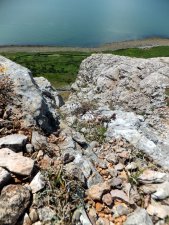 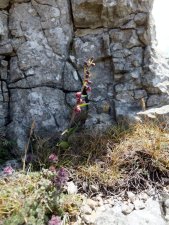 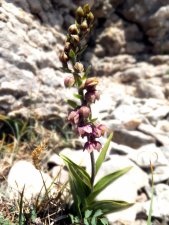 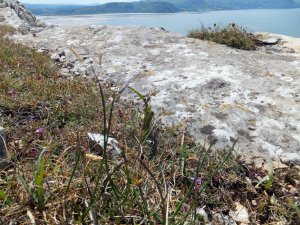
The Great Orme's isolation from the rest of the mainland (Llandudno is built on a tombolo linking the rock to the rest of Wales) has led to dwarf sub-species of Silver-studded Blue and Greyling butterflies. Could the small stature of these DRH and the lack of red pigments in some be a parallel botanical equivalent?
Journeying here I pass along the A55 alongside the coast between Abergele and Rhyl. By Llydfaen Quarry in other years I have seen Common Spotted Orchids growing on the verge going west and in the central reservation going east. This year It was apparent that Pyramidal Orchids are also there in good numbers. I have have been too early in previous years to notice these while driving past at 60mph.
11th July 2015, Ty Brith
A day of visiting old orchid sites, two of which hadn't had a return visit for some years. Ty Brith is a flower meadow in the Welsh borderlands near Oswestry. Both Common Spotted Orchids and Heath Spotted Orchids live here, particularly in the second lower field. I confess I am not good at the fine details and the range of colours and shapes of the Heath Spotted, but while these photos are not typical I doubt that they are hybrids, just extremes of the two species
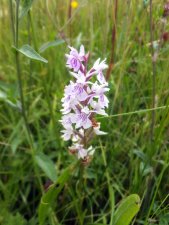 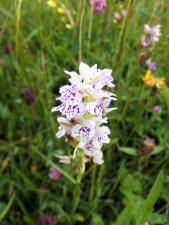 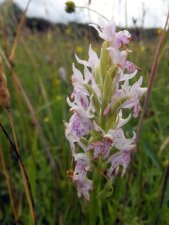 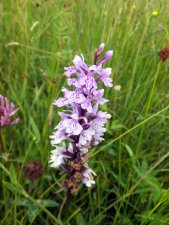
11th July 2015, Scabby Rock
I popped in here in passing as it lay between the two other orchid sites being visited the same day. I didn't expect to find anything new, but it would only take a few minutes. The first thing that struck me was the number of Pyramidal Orchids and their size. Growing, unusually for them, out of direct sun they were very leggy and a number had fallen over due to their height. There was one specimen, just by the track with an extremely large flower spike growing to 62cm. They were also very pale; a sort of pale lilac colour, rather their normal vivid pink - almost washed out. This must be the effect of low light levels on this normally sun-loving plant. Surprisingly there was also one late flowering Greater Butterfly Orchid at the end of its period; the rest had all finished.
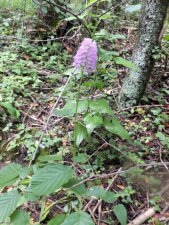 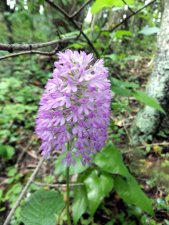 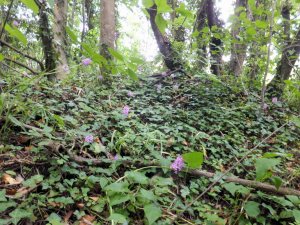 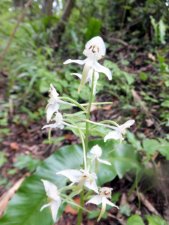
11th (and 18th) July 2015, Sweeney Fen
The one and only time I have visited Sweeney Fen was 8 years ago, and I was ill-prepared in the footwear department, consequently I had to content myself with some zoom shots from the drier area. This is a true fen, in that water from the surrounding calcareous soils accumulates in this natural dip, so take wellies.
Straight off you are greeted by Common Spotted Orchids, and taking the path around the fen and to the right you start to find Marsh Fragrant Orchids and Marsh Helleborines. The latter seem to be of two forms; one with the usual amount of reddish purple, with deep colouration to the inside of the sepals and veining inside the hypochile. The others lack much of this and tend to form a denser inflorescence. These are not var ochroleuca though, as the stems and ovaries still show the usual brownish purple colouration.
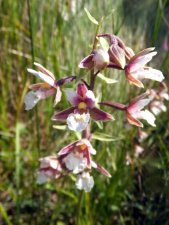 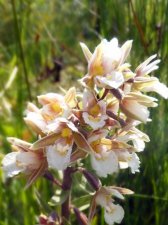
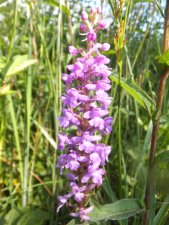 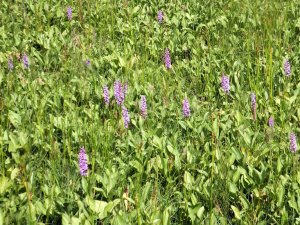 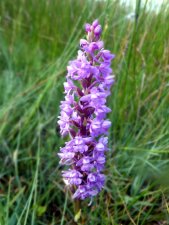
The Marsh Fragrants are numerous, numbering several hundreds (how did I miss them last time?), and you can smell them in the air when the wind has dropped. Of particular interest was the possibility of finding a Common Spotted x Marsh Fragrant hybrid - x Dactylodenia st-quintinii perhaps. What brought them to my attention was their different overall appearance to the Fragrants, being the only ones without a flower opened. In fact it almost seemed the flower may have been deformed and and may never open. They did not show F1 vigour, being smaller than many Fragrants, but the spur is longer than a CSO and shorter than a MFO. The clincher for me though, was the spotted leaves. A return trip may be in order. A comparison between the unopened flowers of the normal and the the presumed hybrid shows significant differences in the spur size, how the petals and sepals are arranged, and the angle at which they are held by the stem.
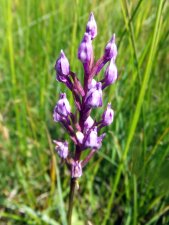 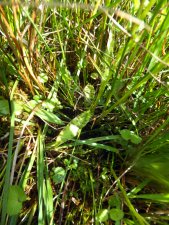 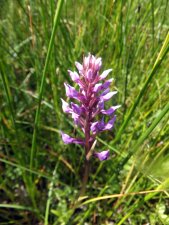 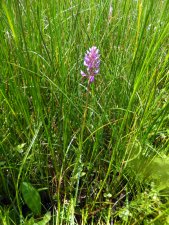 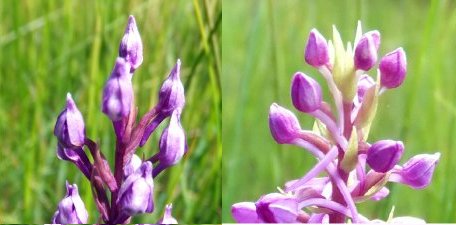
A return visit here a week later and both these unusual orchids can be found again quite easily. This demonstrates that in a field of other Fragrant Orchids and Common Spotteds they do stand out somewhat. Despite the passage of time neither has the flower buds opened and in fact they seem to be dying on the first. Suggestions that these are just Common Spotted Orchids seem less likely, as this species is very much on the way out across the site.
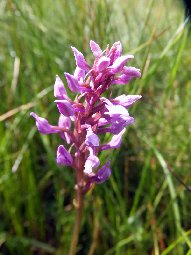 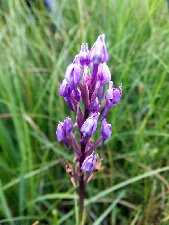
This makes identification difficult, and necessitates the removal of one flower from each to be delicately unfurled back home. This was accomplished by floating them in a shallow dish of water and gently unraveled.
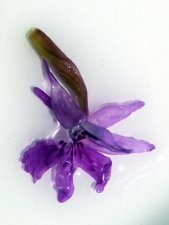 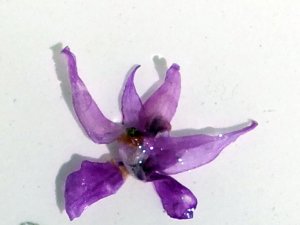
The first example shows much in common with a Common Spotted Orchid flower, with the tridentate lip and the markings. However the colouring is much darker than usual eve allowing for it not being unfurled, and why is this not flowering properly.
The second example has more in common with a Fragrant Orchid being un-patterned and the colour. But why are the flowers dying in bud, and the spur so short.
Neither of these are typical of their species, but neither are typical of x Dactylodenia. So, dare I suggest a deep colour form of the Common Spotted, and more controversially x Gymnorhiza?
12th July 2015, Eryrys
We have visited this small site for the last three years, found by chance discovery in 2013; but only much earlier in the year to see the Frog Orchids. The highlighting on the internet of the clump of rather tall examples has resulted in other visitors, and a couple of posts suggested that a return visit in July would be a good idea. There was a mention of D. x venusta, but we didn't see that. The earlier visits did not suggest how many Common Spotted Orchids are now flowering at the site. And why is there only only Pyramidal Orchid? The Common Twayblades are at the end of their flowering. The smaller Frog Orchids are getting hidden by the grass and other undergrowth that was coming to life, but the larger examples still stand out and the seed pods are developing nicely.
However the BIG surprise is the number of Common Fragrant Orchids that grow all over the site. Earlier in the year there had been no indication of them, or indeed the previous two years. There is a range of depth of colour to the flowers, while some are in full flower and others still in bud showing the big long spurs nicely. Good to see a bit of variation in the lip lobulation, but all within what would be expected for the species.
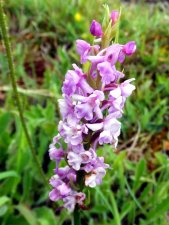 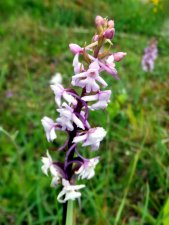 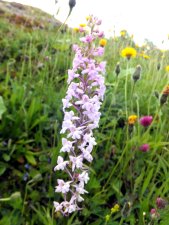 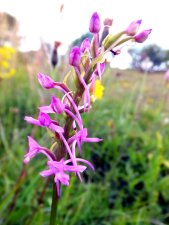 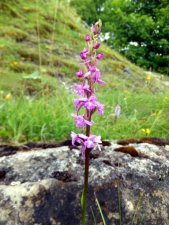 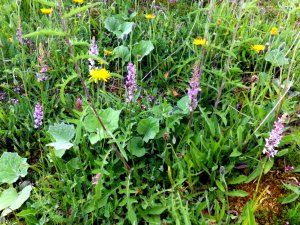
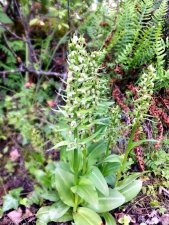 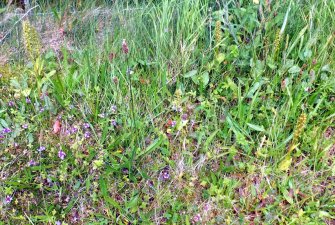 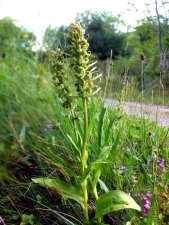
I have been alerted to another small colony of Frog Orchids nearby, across the lane and about 400 metres away. These grow alongside a bridleway and all 13 in flower are larger than average (photos 2 and 3 above). In fact the lane between the two sites had both Common Spotted Orchids and Common Fragrant Orchids growing on the verges. Additionally back away from the village, by the quarry near the Treuddyn crossroads, there are more Common Spotted in the road verge.
Another reason to visit the original site site is the number of butterflies there. Both Ringlets and Small Pearl Bordered Fritillaries were on the wing this time.
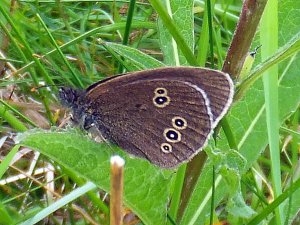 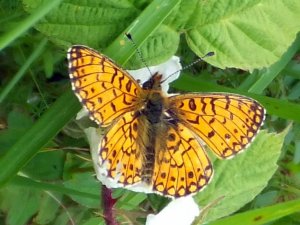
16th July 2015, Alyn Waters Country Park
Visits to three sites very local to me, each with a different Epipactis to look at. I might be a bit early but when you get the Helleborine itch you just have to scratch it.
The Dune Helleborines are only just beginning to flower, but there are plenty yet to come. Today provided an opportunity to photograph them with sunlight through the trees behind them - just for something different. For years these Dunes had been assumed to be Broad-leaved Helleborines - until 2010 when their true identity was discovered. However the BLH are still said to live here. Up till now I hadn't really seen any definites of that species, but examining today's photos revealed some, evidenced by their colours and the purplish brown at the bottom of the ovary stem. I have never been a huge fan of leaf positioning as this, in practice, is not a golden rule and a bit subjective in many cases. This year a short search revealed only one Marsh Fragrant Orchid. The Green-Flowered Helleborines all, repeat all, had been rabbit nibbled from just above the leaves, since my last visit a month ago. No Dune Helleborines had had the same treatment. The GFH flowers must be quite tasty, while the opposite applies to the Dunes.
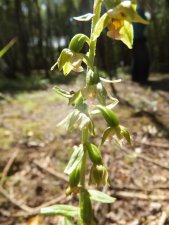 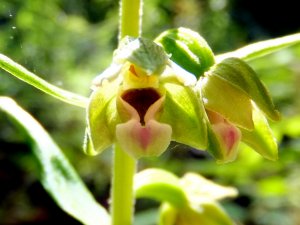 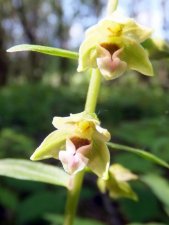
The Dune Helleborines
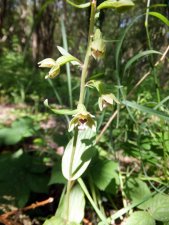 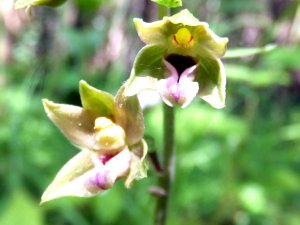 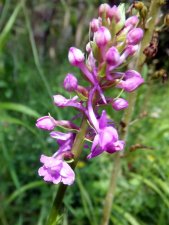
The Broad-leaved Helleborines Marsh Fragrant Orchid
16th July 2015, Marford Quarry
Last year the Green-flowered Helleborines here were very disappointing, seemingly slug attacked. This year did not get off to a good start when the first one found was a single ratty specimen. However the little glade between the path and the track, and the borders of the track up the hill, revealed 20 flowering plants, some of decent size. This is the most I have seen here.
They too, were only just beginning to open, but already some had the column and lip disintegrating, though no signs of ovaries beginning to swell yet. I did get some photos which show the hypochile and epichile are not fully formed and I am veering towards these being sub-species degenera. I may be completely wrong and am open to correction. Unusually, some have a bit of a rosy tinge to the labellum.
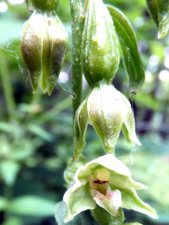 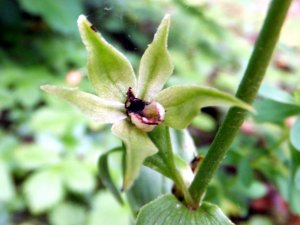 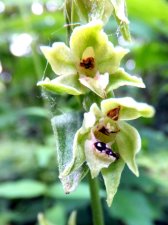
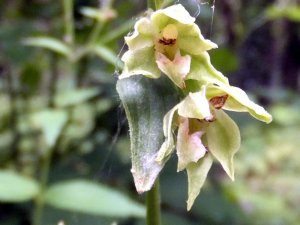 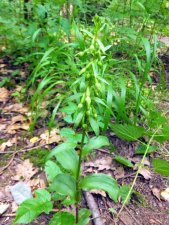 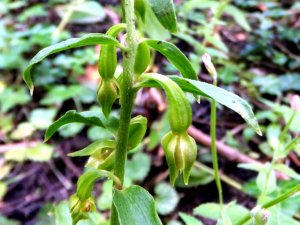
16th July 2015, Marford Woods
The Broad-leaved Helleborines are just a bit later flowering than the two other sites visited today. There are only a few flowers actually open, and it is rather difficult to spot them while still in bud. This make the numbers look less than in other years, but this will probably prove to be deceptive. One shot shows an enterprising spider has built a web around a newly opened flower and has already caught a number of small flying insects that may have been attracted to the flowers.
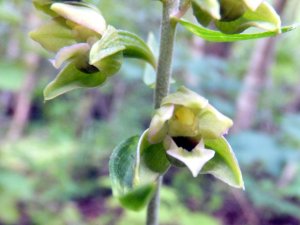 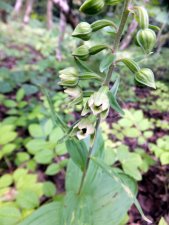 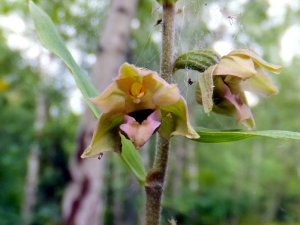
    
|
